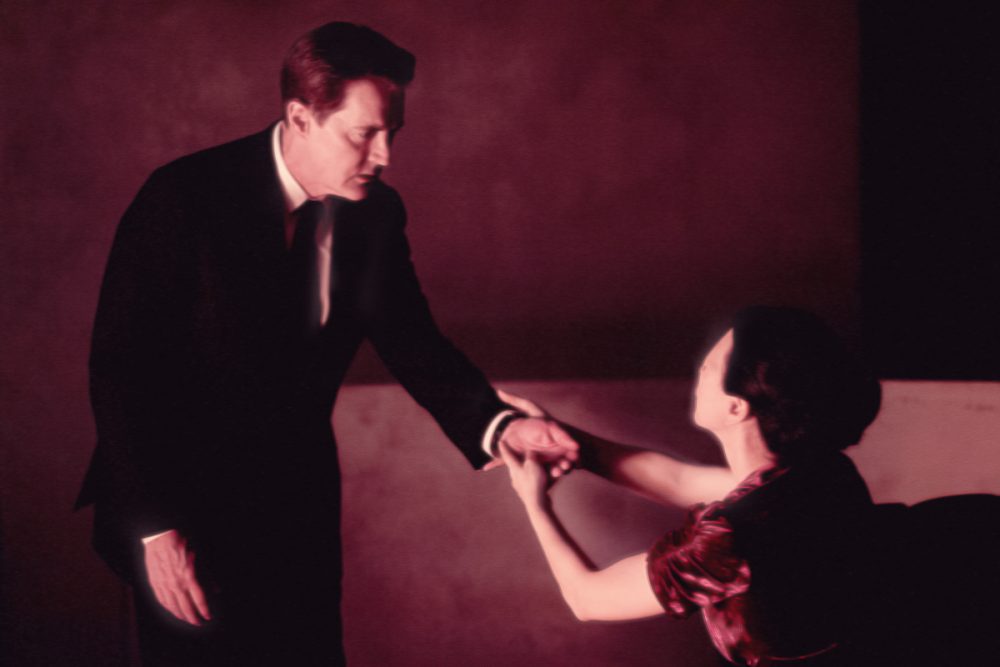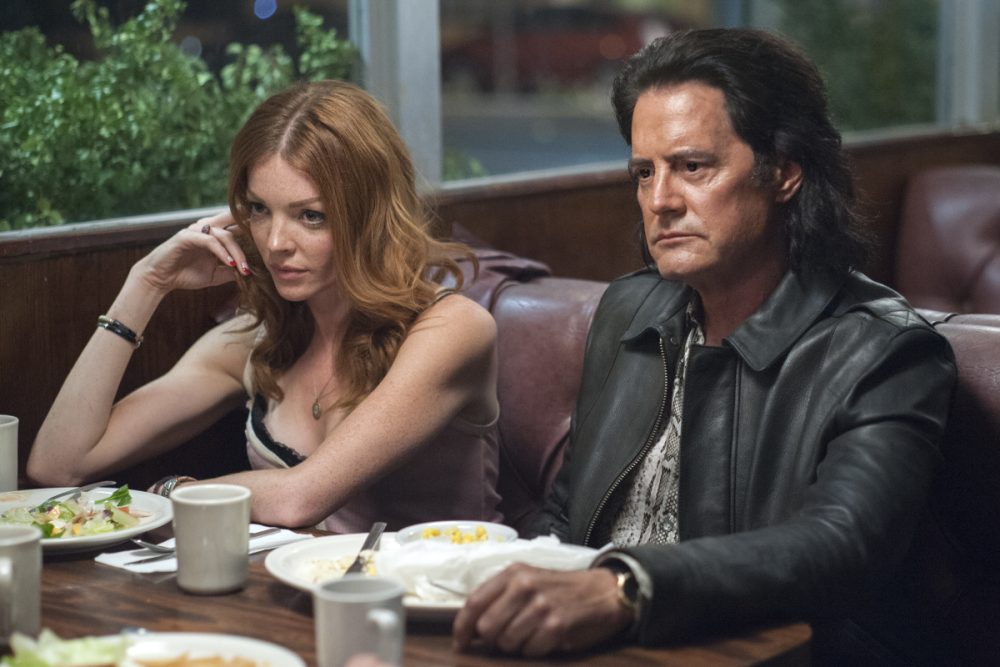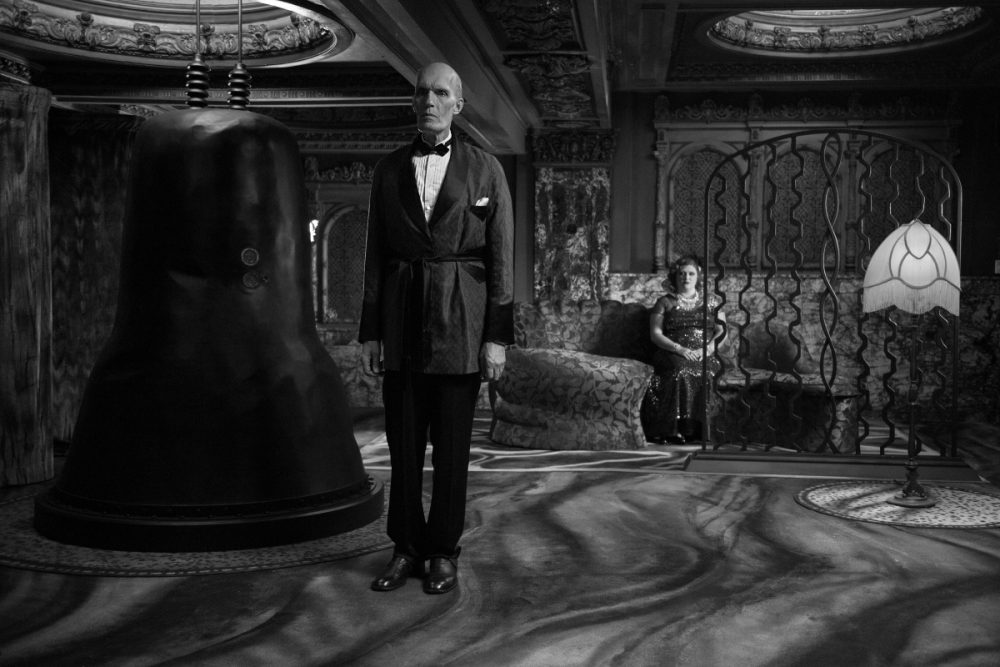Advertisement
Review
Halfway Through, 'Twin Peaks' Has Become A Grand Summation Of Lynch's Singular Career

“The absurd mystery of the strange forces of existence,” sighs Miguel Ferrer’s Albert Rosenfield, the blisteringly sardonic FBI agent with a carefully concealed heart of gold, doing as good a job as anyone probably can of synopsizing “Twin Peaks: The Return.”
We’re now nine hours into the Showtime Limited Series — exactly halfway through director David Lynch’s maddening, magnificent magnum opus — a work of such sweeping breadth and bonkers daring that mere hyperbole feels meager and insufficient. This is the most thrilling, confounding program to be seen on television since ... well, since the original “Twin Peaks” first premiered on ABC back in 1990.
It doesn’t work like other shows. The “prestige television” model for cable series that’s been enshrined by culture writers as a “New Golden Age of TV” in recent years with programs like “Breaking Bad” and “Game of Thrones” tends to favor densely plotted, tightly scripted setups and payoffs. In fact, one of the things keeping me off the TV love train is that in our current binge-watching, serialized-storytelling era popular shows tend to be received primarily as narrative delivery devices — their plotlines incessantly scrutinized while discussions of aesthetics and atmosphere are banished to the back burner. This is a perfectly valid way to enjoy something, just not how I personally prefer to experience art. It’s also a surefire way to lose your damn mind while watching “Twin Peaks.”

This show requires that you surrender to its somnambulist pacing and soak in the eerie aura of Lynch’s sinister sound design and off-kilter edits. “Twin Peaks: The Return” was shot from a 400-page script written by Lynch and original series collaborator Mark Frost, which according to the standard industry formula of one page equaling one minute of screen time should have resulted in an awful lot less than these 18 hours. As such, there are tons of epic, non-verbal stretches and simple conversations elongated almost to the point of parody, the actors sitting for a bit between lines, savoring the awkward silences. Even the most propulsive, plot-heavy episode still featured a static, 3-minute long-take of a guy listening to Booker T. and the M.G.’s “Green Onions” while sweeping the floor.
It’s been designed to hypnotize. The show slows down your biorhythms as you watch it — which makes the sudden bursts of horrifying imagery even more alarming. Most episodes end with a live performance of a soothing synth-pop song at the local Roadhouse, as if easing the audience back to planet Earth.
The story so far? Well the short version is that it’s a tale of two Coopers, with twin investigations to match the dual mountaintops of the title. At the end of the ABC series Kyle MacLachlan’s adorably earnest Special Agent Dale Cooper was trapped in the red-curtained Black Lodge — an extra-dimensional purgatory of terror — while his evil doppelgänger escaped and inflicted bloody havoc with supernatural assistance over these past 25 years, the extent of his awful crimes only beginning to become clear in recent episodes.
The good Cooper finally managed to escape from the Black Lodge, hurtling through time and space and piloting a dirigible over a wine-colored sea alongside an eyeless woman in one of Lynch’s most audacious silent interludes. Now he’s somehow wound up in Las Vegas and has been mistaken for a loutish insurance agent named Dougie Jones. Coop’s brain is so scrambled from the journey that he simply stumbles through scenes in a slapstick stupor, repeating the last couple words of whatever anybody just said to him. Dougie’s plodding pratfalls rub a lot of viewers the wrong way, but I’m quite taken with the beatific innocence and light MacLachlan brings to the performance, especially in contrast with the stark menace of his evil twin.

Dougie is like one of those jokes David Letterman used to specialize in that go on for so long they stop being funny, and then keep going on and on for even longer until eventually they somehow become the funniest thing you’ve ever seen. (There are few filmmakers who take as much delight as Lynch does in trying the patience of an audience. Remember how many of the original show’s most suspenseful episodes included endless shots of elderly people slowly making their way across large rooms.) It’s a kick to see signs of our sidelined hero slowly coming to life inside this infantilized husk, Dougie perking up briefly at trademark Agent Cooper-isms such as badges, breakfast food and his beloved black coffee.
Meanwhile in Buckhorn, South Dakota, our hard-of-hearing FBI Chief Gordon Cole (played with surprising gravity by Lynch himself) and Ferrer’s aforementioned cranky forensics expert are puzzling over local cops discovering the headless body of Major Garland Briggs — who you probably recall as the Air Force investigator of paranormal phenomena portrayed with such great heart and spirit in the original series by the late Don Davis. For reasons nobody can quite fathom yet, Briggs’ corpse is about 25 years younger than it’s supposed to be, and he also had Dougie Jones’ wedding ring in his stomach.
Back in the town of Twin Peaks (hey, remember that place?) Major Briggs’ once-rebellious, coke-dealing son Bobby has straightened out and become a deputy, working with Michael Horse’s Hawk and Robert Forster’s replacement Sheriff Frank Truman, filling in these days for his gravely ill brother Harry. (Interestingly, Forster was Lynch’s first choice to play Harry in the ABC series but the actor couldn’t get out of prior commitments. Michael Ontkean took his place, but declined to participate in this new season, allowing everything to come full circle in a “Peaks”-ian sort of way while bringing yet another double into a story that’s already crawling with them.)

Bobby, Hawk and Frank have been working off a tip by the ailing Log Lady, piecing together clues regarding Cooper’s disappearance 25 years ago, following a trail of breadcrumbs left by Bobby’s father and missing pages from Laura Palmer’s diary. The dead are very much with these characters, and “Twin Peaks: The Return” feels downright haunted by all the cast members who have passed away either since the show originally aired, or in some cases since these new episodes were filmed. It’s impossible not to be moved while watching Catherine Coulson’s Log Lady and Warren Frost’s Doc Hayward take their final bows here on camera.
Most affecting of all is Miguel Ferrer, who died of throat cancer this past January but not before returning to his greatest role one last time to give a performance for the ages. Sweetly sarcastic and secretly vulnerable, Albert’s scowling banter with Lynch’s shouty bureau chief has blossomed into that of a crotchety old married couple, a chemistry only compounded by the arrival of Laura Dern’s boozy, platinum-wigged, potty-mouthed former FBI secretary, Diane. These are two tough, professional men who have seen things in the line of duty that you couldn’t possibly imagine, and they’re both completely, hilariously terrified of her. Albert was always my favorite character on “Twin Peaks,” and every moment spent with Ferrer in this revival feels like a gift.
“Twin Peaks: The Return” has been rolled out with a level of secrecy unprecedented in the internet age. No advance screeners of episodes are given to critics for review, nor are any scenes from next week’s episode tacked onto the closing credits. This total PR blackout led to the amazing communal experience of everyone’s brain melting at the exact same time during the eighth installment, an instantly legendary and insanely traumatic hour of television that traced the origins of the series’ evil beings to a dimensional rift opened up inside a nuclear-testing mushroom cloud.

It was all black-and-white, abstract nightmare fuel to rival Lynch’s “Eraserhead,” culminating an Abraham Lincoln look-alike repeating an unholy incantation as he crushed the skulls of folks in a small town not unlike the one we’ve grown attached to over these three seasons. Then a gross bug monster crawled into a little girl’s mouth and the episode was over. (There was no synth-pop song that week to smooth over the re-entry.)
That such a thing can exist alongside the sublimely silly Wally Brando — a riotous cameo by Michael Cera doing at once the best and worst Marlon Brando impression you’ve ever seen for an increasingly exasperated Robert Forster — indicates the unhinged, everything-plus-the-kitchen-sink scope of Lynch’s ambition here. He hasn’t directed anything since “Inland Empire” back in 2006, and “Twin Peaks: The Return” has the feeling of of this stubborn 71-year-old artist pushing all his chips out into the middle of the table. You can spot references to every movie he’s made up until now, plus a lot of elements kicking around from Lynch’s widely circulated, unproduced screenplays like “Ronnie Rocket” and “One Saliva Bubble.”
As these madly disparate elements all continue to intermingle and jell, “Twin Peaks: The Return” is beginning to feel like the grand summation of a singular career. And we’re only halfway through.
